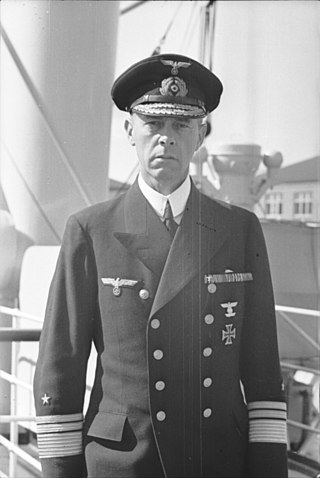
Operation Rheinübung was the sortie into the Atlantic by the new German battleship Bismarck and heavy cruiser Prinz Eugen on 18–27 May 1941, during World War II. This operation to block Allied shipping to the United Kingdom culminated with the sinking of Bismarck.
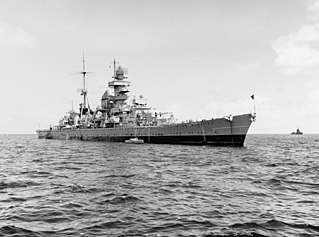
Prinz Eugen was an Admiral Hipper-class heavy cruiser, the third of a class of five vessels. She served with Nazi Germany's Kriegsmarine during World War II. The ship was laid down in April 1936, launched in August 1938, and entered service after the outbreak of war, in August 1940. She was named after Prince Eugene of Savoy, an 18th-century general in the service of Austria. She was armed with a main battery of eight 20.3 cm (8 in) guns and, although nominally under the 10,000-long-ton (10,160 t) limit set by the Anglo-German Naval Agreement, actually displaced over 16,000 long tons (16,257 t).

The Battle of the Denmark Strait was a naval engagement in the Second World War, which took place on 24 May 1941 between ships of the Royal Navy and the Kriegsmarine. The British battleship HMS Prince of Wales and the battlecruiser HMS Hood fought the German battleship Bismarck and the heavy cruiser Prinz Eugen, which were attempting to break out into the North Atlantic to attack Allied merchant shipping.

Operation Berlin was a raid conducted by the two German Scharnhorst-class battleships against Allied shipping in the North Atlantic between 22 January and 22 March 1941. It formed part of the Battle of the Atlantic during World War II. The Scharnhorst and Gneisenau sailed from Germany, operated across the North Atlantic, sank or captured 22 Allied merchant vessels, and finished their mission by docking in occupied France. The British military sought to locate and attack the German battleships, but failed to damage them.

Operation Nordseetour was an unsuccessful raid conducted between 30 November and 27 December 1940 by the German heavy cruiser Admiral Hipper. It formed part of the World War II Battle of the Atlantic, with the heavy cruiser seeking to attack Allied convoys in the North Atlantic. Admiral Hipper left Germany on 30 November 1940 and entered the Atlantic after evading British patrols. She had difficulty locating any convoys, and was plagued by engine problems and bad weather. While returning to Brest in German-occupied France, Admiral Hipper encountered Convoy WS 5A on the night of 24 December. A torpedo attack that night did not inflict any damage, and Admiral Hipper was driven off by the convoy's escorts when she attacked on the next morning. Two British transports and a heavy cruiser were damaged. The German cruiser sank a merchant ship later on 25 December, and arrived in Brest on 27 December.

The Admiral Hipper class was a group of five heavy cruisers built by Nazi Germany's Kriegsmarine beginning in the mid-1930s. The class comprised Admiral Hipper, the lead ship, Blücher, Prinz Eugen, Seydlitz, and Lützow. Only the first three ships of the class saw action with the German Navy during World War II. Work on Seydlitz stopped when she was approximately 95 percent complete; it was decided to convert her into an aircraft carrier, but this was not completed either. Lützow was sold incomplete to the Soviet Union in 1940.

Z36 was one of five Type 1936B destroyers built for the Kriegsmarine during World War II. Completed in early 1944, the ship spent the war in the Baltic Sea, escorting German ships, laying minefields, and bombarding Soviet forces. On 12 December, a navigational error caused her to enter a German minefield as she was preparing to lay another minefield in the Gulf of Finland off the Estonian coast. Z36 struck a single mine and sank with the loss of all hands. The wreck was surveyed in 1994.
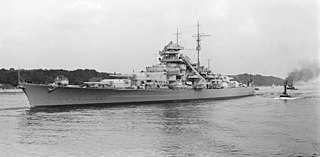
The Bismarck class was a pair of fast battleships built for Nazi Germany's Kriegsmarine shortly before the outbreak of World War II. The ships were the largest and most powerful warships built for the Kriegsmarine; displacing more than 41,000 metric tons normally, they were armed with a battery of eight 38 cm (15 in) guns and were capable of a top speed of 30 knots. Bismarck was laid down in July 1936 and completed in September 1940, while her sister Tirpitz's keel was laid in October 1936 and work finished in February 1941. The ships were ordered in response to the French Richelieu-class battleships. They were designed with the traditional role of engaging enemy battleships in home waters in mind, though the German naval command envisioned employing the ships as long-range commerce raiders against British shipping in the Atlantic Ocean. As such, their design represented strategic confusion that dominated German naval construction in the 1930s.

Scharnhorst was a German capital ship, alternatively described as a battleship or battlecruiser, of Nazi Germany's Kriegsmarine. She was the lead ship of her class, which included her sister ship Gneisenau. The ship was built at the Kriegsmarinewerft dockyard in Wilhelmshaven; she was laid down on 15 June 1935 and launched a year and four months later on 3 October 1936. Completed in January 1939, the ship was armed with a main battery of nine 28 cm (11 in) C/34 guns in three triple turrets. Plans to replace these weapons with six 38 cm (15 in) SK C/34 guns in twin turrets were never carried out.

Johann Günther Lütjens was a German admiral whose military service spanned more than 30 years and two world wars. Lütjens is best known for his actions during World War II and his command of the battleship Bismarck during her foray into the Atlantic Ocean in 1941.
Z5 Paul Jacobi was a Type 1934A destroyer built for the Kriegsmarine in the mid-1930s. The ship was being refitted when World War II began on 1 September 1939 and was tasked to inspect neutral shipping for contraband goods in the Kattegat until early 1940. She participated in the early stages of the Norwegian Campaign by transporting troops to the Trondheim area in early April 1940 and was transferred to France later that year where she made several attacks on British shipping. Paul Jacobi spent most of 1941 under repair and returned to France in early 1942 to successfully escort two German battleships and a heavy cruiser home through the English Channel. The following month, the ship helped to escort another German battleship to northern Norway and returned in May to begin another lengthy refit.

Z7 Hermann Schoemann was a Type 1934A-class destroyer built for Nazi Germany's Kriegsmarine in the mid-1930s. The ship was plagued by machinery problems for most of her life and was under repair when the Second World War began in September 1939. She covered her sister ships over the next few months as they laid offensive minefields in English waters in late 1939 – early 1940. Hermann Schoemann played a minor role in the Norwegian Campaign as engine problems limited her availability throughout 1940 and for most of 1941.
Z14 Friedrich Ihn was a Type 1934A-class destroyer built for Nazi Germany's Kriegsmarine in the mid-1930s. The ship was named after the First World War German naval officer Friedrich Ihn. At the beginning of World War II, the ship was initially deployed to blockade the Polish coast, but she was quickly transferred to the German Bight to lay defensive minefields in German waters. In late 1939 and early 1940, the ship laid multiple offensive minefields off the English coast that claimed 18 merchant ships and a destroyer. Ihn was under repair during the Norwegian Campaign of early 1940 and was transferred to France later that year.
Z15 Erich Steinbrinck was a Type 1934A-class destroyer built for Nazi Germany's Kriegsmarine in the mid-1930s. The ship was named after the First World War German naval officer Erich Steinbrinck. At the beginning of World War II on 1 September 1939, the ship was initially deployed to blockade the Polish coast, but she was quickly transferred to the North Sea to lay defensive minefields. In late 1939 and 1940 the ship laid multiple offensive minefields off the English coast that claimed 24 merchant ships and a destroyer. Steinbrinck was under repair for most of the Norwegian Campaign of early 1940 and was transferred to France later that year.

Z20 Karl Galster was one of six Type 1936 destroyers built for the Kriegsmarine in the late 1930s. Completed in early 1939, the ship spent most of her time training. At the beginning of World War II in September, she was initially deployed to lay minefields off the German coast, but was soon transferred to the Skagerrak where she inspected neutral shipping for contraband goods. In late 1939 and early 1940, Z20 Karl Galster helped to laid three offensive minefields off the English coast that claimed one British destroyer, a fishing trawler, and twenty merchant ships. After a refit that prevented her from participating in the German invasion of Norway in April, the ship was sent to Norway for escort duties. Later that year Z20 Karl Galster was transferred to France, where she made several attacks on British shipping.
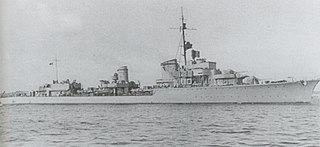
Z28 was one of fifteen Type 1936A destroyers built for the Kriegsmarine during World War II. Built as a flotilla leader with fewer guns than her sister ships, she was completed in 1941. The ship spent most of the first few years of her service in Norwegian waters, escorting convoys and laying minefields. Z28 ran aground in early 1943 and spent the rest of the year under repair. The ship briefly returned to Norway at the beginning of 1944, but was transferred to the Baltic shortly afterwards to support minelaying operations in the Gulf of Finland. That was her primary focus through July and then she began escorting German cruisers as they bombarded Soviet troops ashore in addition to German convoys evacuating people from Finland and the Baltic States.

SS Egerland was an oil tanker used by the German Navy in World War II. As the SS North America it was ordered from Deutsche Werft Finkenwerder for the Panama Transport Company as in July 1940, for transatlantic shipments to Germany. In March 1941, it was decided to transfer ownership to the Texas Oil Company. In 1941, the tanker was requisitioned by the Kriegsmarine, renamed to Egerland and converted to a support ship of the Trossschiffverband der Kriegsmarine for naval operations in the Atlantic. On the first mission in June 1941, to support commerce raiding by the German battleship Bismarck and the cruiser Prinz Eugen, the ship encountered the British heavy cruiser HMS London on 6 June and was scuttled to avoid capture.

SS Gedania was an oil tanker built in 1919-1920 at Kiel, Germany for the Standard Oil of New Jersey's transatlantic shipments to Germany, and registered under the flag of the Free City of Danzig. In 1940, the tanker was requisitioned by the Kriegsmarine and converted to a support ship for naval operations in the Atlantic. On the first mission in July 1941, to support commerce raiding by the German battleship Bismarck and cruiser Prinz Eugen, Gedania was captured and taken into service with the British Ministry of War Transport as Empire Garden. In 1947 it returned to commercial service as Southern Garden with the South Georgia Company, transporting whale oil from the southern Atlantic, and carrying supplies and personnel to the whaling stations. The tanker was broken up in 1960.
MV Alstertor was a refrigerated cargo ship built in 1938 for Anders Jahres Rederi A/S of Sandefjord, Norway by Oresundsvarvet, Landskrona, Sweden as MV Rose. In 1939 a German ship-owning firm, Rob. M. Sloman, bought her to transport fruit between Santos, Brazil and Hamburg. In 1940 the Kriegsmarine requisitioned her and converted her into a support ship for naval operations in the Atlantic.
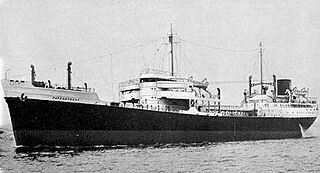
Lothringen was an oil tanker ordered for Dutch shipowner Phs. Van Ommeren under the name Papendrecht in Rotterdam. On 16 May 1940, the Kriegsmarine seized her when the ship was still under construction and she was renamed Lothringen. She was commissioned on 23 January 1941. The ship became the property of Erste Deutsche Walfang-Gesellschaft of Hamburg who converted her into a support ship for naval operations by the German battleship Bismarck and cruiser Prinz Eugen in the Atlantic. On 15 June 1941, Lothringen was captured by the British light cruiser HMS Dunedin and taken into service of the Admiralty, crewed by the Royal Fleet Auxiliary. It was renamed Empire Salvage in 1941 and served the Allies for the remainder of the war. After the war, it was handed back to its owners.
















